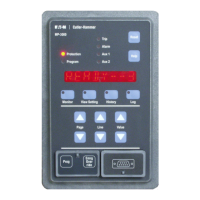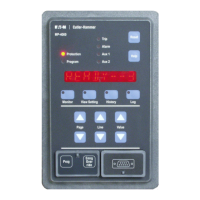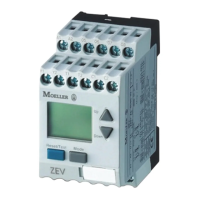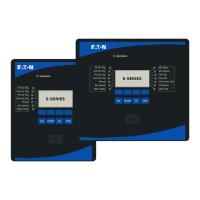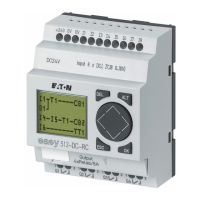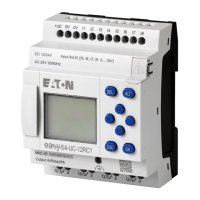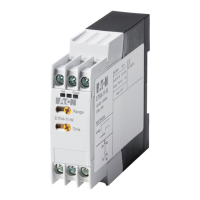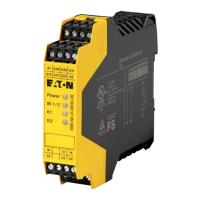Page 6-2
Effective 10/02For more information visit: www.cutler-hammer.eaton.comIL17562BH04
Pass the motor phase conductors through the window of the flux-
canceling ground Ct. The ground Ct need not have any particular
polarity relationship to the phase Cts.
To minimize problems with Ct saturation during faults, keep the Ct
wiring as short as possible and use very heavy wire. The total
resistance of the connecting wire should not be much larger than the
secondary resistance of the Ct itself. The MP-3000 presents very low
burden.
Every phase and ground ct circuit must have one and only one
grounding point. Figure 6.6 shows the common neutral connection of
the three phase Cts, and the ground fault Ct, connected at one point to
a non-current-carrying ground. Do not use a neutral or current-carrying
conductor for this grounding - the noise will disrupt MP-3000 measure-
ments.
Residual connection of the phase Ct secondaries to form a ground
current signal will not give sensitivity approaching that of the flux-
canceling ground Ct. See Section 9.1.10.
6.2.2 Output Contact Wiring
See Specifications for ratings of output contacts, and check against
controlled loads.
Figure 6.6 shows a typical connection of MP-3000 output relay
contacts in the motor control circuits. However, the outputs other than
the trip relay are completely programmable, so there can be nearly
infinite choice in the connection and use of these outputs for tripping,
alarming, and auxiliary control.
The installation design engineer must study Sections 5 and 9 to
understand the available output functions and programming options.
This engineer must record and confirm the settings, and also design a
consistent connection of the form c contacts of the four output relays
to the motor control system.
Pay attention to these features of the programming and contact use:
• Each relay can be set as Mode 1 (normally de-energized; energized
to activate) or Mode 2 (normally energized; de-energize to activate).
Weigh this against the use of NO versus NC contacts in the control
scheme. See Section 5.12.1.
• All trips are steered to the trip relay (terminals 11-12-13) without
choice - connect this to the contactor or trip coil. For all other relays
and functions, the user chooses what function activates which relay.
• It is recommended to use the alarm relay in Mode 2, and to direct all
alarm conditions to it. Connect the annunciator to terminals 17 and
18. With this connection, an alarm will be given if the relay or its
power supply fails; as well as for all other problems the MP-3000
can actively report. However, if the MP-3000 is de-energized
routinely in service, use the alarm relay in Mode 1 and connect the
annunciator to terminals 18 and 19 to avoid nuisance alarms.
• If the relay AUX 1 is set for the process load shedding function, it
can’t be used for anything else.
• If the relay AUX 2 is set for transition control of a reduced-voltage
starter, it can’t be used for anything else.
6.2.3 AC supply wiring
Refer to Figure 6.7. Connect terminals 4 and 7 to a source of control
power rated at either 120 Vac or 240 Vac. The MP-3000 automatically
configures its power supply to work with one or the other value.
Nominal values other than 120 Vac or 240 Vac are not recommended.
However, the MP-3000 is well able to handle depressions, dips, and
limited sustained variations in the normal course of service. See
Specifications.
The optional URTD module can operate only from 120 Vac. For a 240
Vac source, use a step-down transformer suitable for a load of 6 VA.
Do not attempt to power the URTD from the MP-3000 120 Vac discrete
source—that source is for contact reading only and cannot handle the
URTD burden.
If the supply is a dc battery system, use the optional IQ DC power
supply. The IQ DC supply is able to power the MP-3000, the URTD if
used, and the discrete input circuits of the MP-3000. The total burden
capability of the IQ DC module is 30 VA, and it can operate from
nominal voltages of 40 Vdc to 250 Vdc. See IQ DC Power Supply
Module I.L. 17286.
6.2.4 Discrete input contact wiring
Refer to Figures 6.7 and 6.8. The particular contacts to be connected
depend on the settings programmed in the MP-3000 - there is a long
list of functions which can be assigned to each of these inputs.
The engineer designing the installation should study Sections 5 and 9
to understand and designate the use, if any, of the discrete contact-
sensing inputs. Note that only one use can be assigned to each input.
CAUTION
THE DISCRETE INPUTS SHOULD BE ENERGIZED ONLY FROM 120
VAC. THE MP-3000 TERMINAL 6 IS ALWAYS A SOURCE OF 120
VAC, WHICH CAN BE USED TO WET REMOTE CONTACTS, EVEN
WHEN THE MP-3000 IS POWERED FROM 240 VAC.
The discrete input circuits are totally isolated from the other circuits in
the MP-3000, and have their own common connection, terminal 9. If
the 120 Vac discrete contact-wetting source from terminal 6 is used, tie
the discrete input common terminal 9 to the ac supply neutral terminal
7, as shown in Figure 6.7.
Figure 6.8, lower portion, shows an alternate scheme for using a
remote contact wetting source. The source must be 120 Vac. The
contact signal(s) and the remote neutral must be brought to the MP-
3000 discrete inputs. For noise immunity and safety, do not connect
the discrete common terminal 9 to terminal 7 or any other nearby
neutral if a remote wetting source is in use.
CAUTION
BEWARE OF LARGE SHUNT CAPACITANCE ACROSS CONTACTS
OR IN SOLID-STATE RELAYS CONNECTED TO THE MP-3000
DISCRETE INPUTS. CHARGING CURRENT THROUGH THE
CAPACITOR COULD CAUSE A FALSE INDICATION OF A CLOSED
CONTACT. KEEP TOTAL CAPACITANCE BELOW 0.05 MICROFAR-
ADS.
6.2.5 Analog output wiring
Terminals 24 and 25 provide an isolated source of dc current between
4 and 20 mA, the exact value indicating an internal MP-3000 measure-
ment. This current source, if used, is typically connected to a remote
panel meter or a programmable logic controller.
The measurement selection is made via MP-3000 setting. Choices
include motor current; stator winding temperature; and fill level of the
rotor thermal-model bucket between cool level and trip level. See
Setting P11L1 in Section 5.
The burden of the connected current loop should be less than 1000
ohms.

